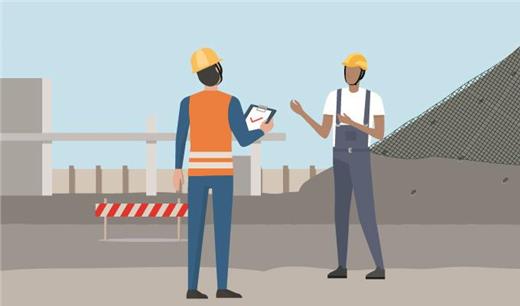Case Studies
Our case studies contain analysis and discussion points for users to better understand the legal provisions. They also provide suggestions on how to prevent corruption, fraud and malpractices.
A large building project developed by a public body (PB), involving five residential blocks and a commercial complex with a car park, should be completed by April 2003. The PB awarded the project to a main contractor CK Holdings Ltd (CK) in May 2001 at $1,800 million. Central Architects and Engineers Ltd (CAE) was appointed by the PB as the project consultant.
There were a number of sub-contractors responsible for different aspects of work for this project. Among them, CK sub-contracted all plastering works to Diamondhead Plastering Company and CHONG was its proprietor.
Being the project consultant, CAE was responsible for monitoring and supervising the workmanship and progress of work including that for CK and its various sub-contractors. CAE had recruited a team of five residential site supervisory staff headed by a Clerks of Works (CoW) Martin. All of them were public servants acting as an agent for the PB in the project.
CHONG, Martin and other site supervisory staff of CAE always had dinner together and played mahjong after work. Being a habitual gambler, Martin was in great debt and often borrowed money from his relatives and friends.
CHONG also invited Martin to Shenzhen on several occasions to have lavish meals and attend nightclubs. CHONG paid all the bills on these occasions. Furthermore, CHONG sometimes offered Martin loans and chips in the casinos in Macau. Martin considered CHONG treated him well solely on friendly basis.
Shortly after their visits to Shenzhen and Macau, CHONG went to Martin’s site office and suggested to adopt a quicker method for laying screed. Instead of using a thorough mixture of cement, sand, aggregate and water, CHONG proposed to adopt a ‘semi-dry sand’ method in which a layer of sand was put onto a layer of cement and thereafter water was sprayed onto the layers. Although this shortcut method of laying screed was used in some other projects, it was not allowed in this project and it was clearly stipulated in the Specifications. Thus, Martin immediately objected to the suggestion.
On the day before Winter Solstice, CHONG approached Martin again and pleaded for relaxation on the screeding method. He indicated that the screeding work had been behind schedule and the liquidated damage for delay was heavy. CHONG offered a laisee packet of $50,000 to Martin claiming that it was for the forthcoming Winter Solstice and requesting for ‘flexibility’ in acceptance of work completed. He also demanded Martin not to be too stringent when inspecting the work. He further indicated that since he had been treating Martin well for so long it should be time for Martin to do something in return. Finally, Martin decided to accept the bribe, accede to CHONG’s request and connive at the shortcut screeding method.
CHONG and Martin were later arrested by the ICAC and were found guilty of offences under Section 4 of the Prevention of Bribery Ordinance (POBO).
Questions
- How did CHONG and Martin violate the POBO?
- What do you think about the over-socialisation between Martin and CHONG?
- Is customary practice, such as giving laisees during festivals (開工利是), a defence to accept an advantage? Why?
- Being a habitual gambler, what is the possible risk of Martin in respect of corruption?
A Government Department (the Department) awarded a slope maintenance contract to Chongs Construction Company Ltd, which then sub-contracted the works to JKW Subcontracting Company (JKW), of which CHEUNG was the proprietor.
From time to time, the Department issued to the contractor works orders (WOs) describing the work required, location and estimated value of the work. Upon completion of work, an Inspector of Works (IoW) of the Department would physically inspect and verify whether the work done was in compliance with the required standard. Based on the recommendation made by the IoW, the project engineer would approve payment to the contractor by signing on the WO concerned. He was not required to physically inspect every piece of work completed as over a hundred WOs were issued every month.
When the engineer signed on the WO, the contractor could apply for payment by submitting the WO to the Accounting Section of the Department. A contractor could only apply for payment on completion of work as certified on the WO.
In conjunction with the payment process, the Quantity Surveying Section of the Department counter-checked the work of the contractor. However, the Quantity Surveyors of the Section could only randomly check 10% of the WOs issued. Both the project engineer and the quantity surveyors might therefore not be able to detect abuse in relation to the WOs.
YAU was an IoW of the Department responsible for overseeing the works carried out by JKW. In March 2000, CHEUNG approached YAU and urged YAU to expedite the checking of WOs. Hence, CHEUNG could receive payment earlier. In return, CHEUNG offered YAU a part-time job with $8,000 a month.
Between April 2000 and December 2001, YAU accepted a part-time job from CHEUNG as a reward for expediting the checking of WOs issued to CHEUNG. On many occasions, YAU certified work completion on the WOs though the work concerned had not even commenced.
YAU and CHEUNG were later arrested by the ICAC and were found guilty of offences under Section 4 of the Prevention of Bribery Ordinance (POBO). Both YAU and CHEUNG were sentenced to imprisonment.
Questions
- How did YAU and CHEUNG violate Section 4 of the Prevention of Bribery Ordinance?
- Besides the offer of a part-time job, what else can be classified as an“advantage”?
- What should be watched out for in site supervision to prevent malpractice?
In a construction project of a commercial complex valued over $500 million, the main contractor employed ten Foremen to monitor the work of sub-contractors. A Site Engineer of the company, who took charge of the Foremen, was responsible for the overall supervision of the project.
The salaries of the Foremen and other workers were calculated on a daily basis. Each of them was required to punch an attendance card when reporting on and off duty every day. The attendance cards and the punching machine were placed in the Engineer’s office so that when the Foremen and other staff reported on or off duty, they had to punch the cards in the Engineer’s office. The Engineer was responsible for ascertaining that his subordinates personally punched the cards. At the beginning of each month, the Engineer was responsible for calculating the salaries of his subordinates based on their individual attendance records for the previous month. His calculations and the punched cards were then sent to the Accounts Department of the company for processing salary payment.
As the family of one of the Foremen, CHAN, was in Chinese Mainland, CHAN would seek every opportunity to go to the Mainland to see his family. One day, CHAN went to see the Engineer and requested for three days’ off. CHAN, however, requested the Engineer not to record his leave but instead punched the attendance card for him so as to show that he was working on the three days. In return, CHAN offered the Engineer $500 for assisting him in punching the attendance card and turning a blind eye to his absence.
The Engineer turned down the offer and reported the matter to the ICAC. Eventually, CHAN was convicted for offering a bribe to the Engineer, contrary to Section 9 of the Prevention of Bribery Ordinance (POBO) and was sentenced to imprisonment.
Questions
- Has the Foreman committed any criminal offence?
- If the Engineer rejects the bribe but still assists the Foreman in falsifying attendance, has the Engineer committed any bribery offence?
- If the Engineer accepts the bribe from the Foreman for assisting him in forging attendance records, what would be the possible consequences to the Engineer?
In January 2001, Lee & Wong Holdings Ltd (LW) awarded a $1,000 million contract to a main contractor for constructing four 40-storey residential blocks, a commercial complex and a car park. The main contractor then sub-contracted the piling work to another company. The latter in turn awarded the work to Saar Piling Company Ltd (Saar) by simply deducting 15% of his original successful bid. LW also appointed a consultant firm Joe & Partners (JP) to oversee the construction work. The project was scheduled to be completed in twenty months and five months were allowed for the piling works.
JP deployed an engineer as the Project Manager (PM) to oversee the project but he was not required to be resident on site. Occasionally, he would go to the site for meetings but did not carry out site inspections himself. Routine site inspection was left to an Assistant Inspector of Works (AIoW) and a Works Supervisor (WS) who were resident site staff appointed by JP. However, the AIoW had very limited experience in piling work.
As there were only two supervisory staff on site responsible for overseeing the whole piling works, the AIoW and the WS found it difficult to check every detail during the work process. They could only rely on the records of Saar and sign the completion forms taking the face value without checking.
Due to unexpected difficulty encountered during the placing of reinforcement casings, LAM, Director of Saar, found that the piling work was behind schedule and a one-month delay was anticipated. Saar, being a small sub-contracting company, found it difficult to bear possible substantial liquidated damage (LD) of $800,000 per day as stipulated under the main contract.
LAM then discussed the making of shortened piles with the foreman and site agent of the main contractor, who were always away from work and thus failed to monitor the work progress. They thought that the specifications stipulated in the contract were conservative and shortened piles should cause no severe harm to the completed buildings resting on top of the piles. They believed that the buildings would not be structurally affected.
LAM instructed his workers not to excavate the pile bores as deep as the proposed founding levels. Instead, after the length of the reinforcement casings had been checked by the supervisory staff of JP, LAM asked his workers to cut the casings during night time when the consultant site supervisory staff were off duty. LAM then manipulated a measuring tape by removing parts of its central portion so that it gave a reading longer than the actual measurement. When the supervisory staff of JP measured the pile bore depth using the manipulated measuring tape provided and re-examined the reinforcement casing, they were not able to detect that the piles had been shortened.
One day, the WS of JP discovered that the length of the constructed piles did not match with the concrete delivery records for the piles. He suspected that some of the piles might have been shortened. He immediately approached LAM for an explanation for the irregularities discovered and the proposals for remedial actions.
LAM, after discussion with the foreman and site agent, went to the WS’s office to hand him an envelope containing $300,000 and plead him to turn a blind eye to the substandard piling works. The WS immediately refused LAM’s request.
The WS immediately reported LAM’s offering of bribes to the ICAC. LAM, the site foreman and site agent of the main contractor were arrested and convicted of conspiracy to offer an advantage to the WS as a reward for turning a blind eye on substandard piling work.
Questions
- Why were LAM, the foreman and site agent convicted of corruption offences? What actions should you take when being offered bribes?
- How devastating would the damages be if a construction professional accepts advantages for turning a blind eye to substandard works? What are the consequences of such behaviour?
- What is the importance of site supervision at a construction site?
A senior engineer of a consultancy firm was offered shares of a company from his friend who was a subcontractor in a private housing estate project. The subcontractor asked him to exercise work discretion to approve additional claims.





